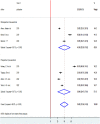Prevalence of homebirth preference and associated factors among pregnant women in Ethiopia: Systematic review and meta-analysis
- PMID: 37967092
- PMCID: PMC10651027
- DOI: 10.1371/journal.pone.0291394
Prevalence of homebirth preference and associated factors among pregnant women in Ethiopia: Systematic review and meta-analysis
Abstract
Background: Homebirth preference is the intention/plan to give birth outside health facilities with the help of unskilled birth attendants. The preference to give birth at home without a skilled birth attendant leads to care-seeking delays, intrapartum mortality, multiple stillbirths, and postpartum morbidities and mortality. Therefore, this study aimed to estimate the pooled prevalence of homebirth preference and associated factors among pregnant women in Ethiopia.
Methods: Search of Google Scholar, Medline, PubMed, Cochrane Library and Web of Science were done for this study from 20th August 2022 to 6th November 2022. For data extraction and analysis, the standardized data extraction checklist and Stata version 14 were used respectively. Sentence as "Cochrane Q test statistics and I2 statistics were used to check heterogeneity of the studies. The pooled prevalence of homebirth preference was estimated using a random-effects model. The association between homebirth preference and independent variables was determined using an odd ratio with a 95% confidence interval. A funnel plot and Egger's test were used to assess publication bias.
Results: A total of 976 research articles were identified. Seven studies that fulfilled eligibility criteria were included in this systematic review and meta-analysis. The pooled prevalence of homebirth preference in Ethiopia was 39.62% (95% CI 27.98, 51.26). The current meta-analysis revealed that average monthly income <1800 ETB (OR = 2.66, 95% CI 1.44, 4.90) lack of ANC follow-up (OR = 2.57, 95%CI 1.32, 5.01), being multipara (OR = 1.77, 95%CI 1.39, 2.25), poor knowledge about obstetric danger sign (OR = 5.75, 95%CI 1.o2, 32.42), and not discussing the place of delivery with a partner (OR = 5.89 (95%CI 1.1, 31.63) were significantly associated with homebirth preference.
Conclusion: This systematic review and meta-analysis examined the substantial prevalence of homebirth preference in Ethiopia which may contribute maternal and child health crisis. The homebirth preference was associated with low average monthly income (<1800 ETB), lack of ANC follow-up, multipara, poor knowledge about obstetric danger signs, and not discussing with their partner the place of delivery. Improving knowledge of pregnant women about the benefit of health facility delivery and obstetric danger signs is necessary to decrease the prevalence of homebirth preference; for these can reduce negative outcomes occurred during delivery.
Copyright: © 2023 Feyisa et al. This is an open access article distributed under the terms of the Creative Commons Attribution License, which permits unrestricted use, distribution, and reproduction in any medium, provided the original author and source are credited.
Conflict of interest statement
The authors have declared that no competing interests exist.
Figures














Similar articles
-
Preference of homebirth and associated factors among pregnant women in Arba Minch health and demographic surveillance site, Southern Ethiopia.PLoS One. 2022 Oct 27;17(10):e0276682. doi: 10.1371/journal.pone.0276682. eCollection 2022. PLoS One. 2022. PMID: 36301942 Free PMC article.
-
Magnitude of postpartum hemorrhage and its associated factors in Ethiopia: a systematic review and meta-analysis.Reprod Health. 2022 Mar 9;19(1):63. doi: 10.1186/s12978-022-01360-7. Reprod Health. 2022. PMID: 35264188 Free PMC article.
-
Birth preparedness and complication readiness among pregnant women in Ethiopia: a systematic review and Meta-analysis.Reprod Health. 2018 Oct 29;15(1):182. doi: 10.1186/s12978-018-0624-2. Reprod Health. 2018. PMID: 30373598 Free PMC article.
-
Prevalence of Urinary Tract Infection and Its Associated Factors among Pregnant Women in Ethiopia: A Systematic Review and Meta-Analysis.Biomed Res Int. 2021 Dec 1;2021:6551526. doi: 10.1155/2021/6551526. eCollection 2021. Biomed Res Int. 2021. PMID: 34901276 Free PMC article.
-
Association between pregnancy intention and late initiation of antenatal care among pregnant women in Ethiopia: a systematic review and meta-analysis.Syst Rev. 2020 Aug 20;9(1):191. doi: 10.1186/s13643-020-01449-9. Syst Rev. 2020. PMID: 32819428 Free PMC article.
Cited by
-
Impact of disrespectful maternity care on childbirth complications: a multicentre cross-sectional study in Ethiopia.BMC Pregnancy Childbirth. 2024 May 21;24(1):380. doi: 10.1186/s12884-024-06574-0. BMC Pregnancy Childbirth. 2024. PMID: 38773395 Free PMC article.
-
Trend of home birth and its associated factors in Ethiopia during COVID-19 and social crisis (2019-2023).PLoS One. 2025 Mar 31;20(3):e0320859. doi: 10.1371/journal.pone.0320859. eCollection 2025. PLoS One. 2025. PMID: 40163500 Free PMC article.
References
Publication types
MeSH terms
LinkOut - more resources
Full Text Sources

